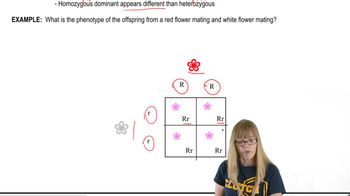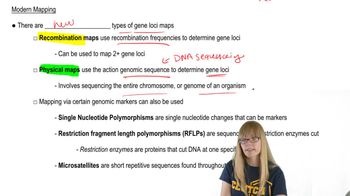Table of contents
- 1. Introduction to Genetics51m
- 2. Mendel's Laws of Inheritance3h 37m
- 3. Extensions to Mendelian Inheritance2h 41m
- 4. Genetic Mapping and Linkage2h 28m
- 5. Genetics of Bacteria and Viruses1h 21m
- 6. Chromosomal Variation1h 48m
- 7. DNA and Chromosome Structure56m
- 8. DNA Replication1h 10m
- 9. Mitosis and Meiosis1h 34m
- 10. Transcription1h 0m
- 11. Translation58m
- 12. Gene Regulation in Prokaryotes1h 19m
- 13. Gene Regulation in Eukaryotes44m
- 14. Genetic Control of Development44m
- 15. Genomes and Genomics1h 50m
- 16. Transposable Elements47m
- 17. Mutation, Repair, and Recombination1h 6m
- 18. Molecular Genetic Tools19m
- 19. Cancer Genetics29m
- 20. Quantitative Genetics1h 26m
- 21. Population Genetics50m
- 22. Evolutionary Genetics29m
4. Genetic Mapping and Linkage
Mapping Genes
Problem 10
Textbook Question
Colored aleurone in the kernels of corn is due to the dominant allele R. The recessive allele r, when homozygous, produces colorless aleurone. The plant color (not the kernel color) is controlled by another gene with two alleles, Y and y. The dominant Y allele results in green color, whereas the homozygous presence of the recessive y allele causes the plant to appear yellow. In a testcross between a plant of unknown genotype and phenotype and a plant that is homozygous recessive for both traits, the following progeny were obtained: colored, green 88 colored, yellow 12 colorless, green 8 colorless, yellow 92 Explain how these results were obtained by determining the exact genotype and phenotype of the unknown plant, including the precise arrangement of the alleles on the homologs.
 Verified step by step guidance
Verified step by step guidance1
Identify the phenotypes and genotypes of the progeny: colored, green (R_Y_), colored, yellow (R_yy), colorless, green (rrY_), and colorless, yellow (rryy).
Recognize that the testcross involves a homozygous recessive plant (rryy) and an unknown plant, which will reveal the unknown plant's genotype based on the progeny ratios.
Calculate the recombination frequency using the progeny numbers: (12 + 8) / (88 + 12 + 8 + 92) to determine if the genes are linked.
Determine the most frequent progeny phenotypes (colored, green and colorless, yellow) as the parental types, indicating the unknown plant's genotype is RrYy with alleles in coupling phase (RY/ry).
Conclude that the unknown plant's genotype is RrYy, with the alleles R and Y on one homolog and r and y on the other, based on the observed progeny ratios and recombination frequency.
Recommended similar problem, with video answer:
 Verified Solution
Verified SolutionThis video solution was recommended by our tutors as helpful for the problem above
Video duration:
1mPlay a video:
Was this helpful?
Key Concepts
Here are the essential concepts you must grasp in order to answer the question correctly.
Dominant and Recessive Alleles
In genetics, alleles are different forms of a gene that can exist at a specific locus on a chromosome. Dominant alleles, represented by uppercase letters (e.g., R, Y), express their traits even when only one copy is present, while recessive alleles (e.g., r, y) require two copies to manifest their traits. Understanding the dominance hierarchy is crucial for predicting phenotypic outcomes in offspring based on parental genotypes.
Recommended video:
Guided course

Variations on Dominance
Testcross
A testcross is a breeding experiment used to determine the genotype of an individual with a dominant phenotype. This is achieved by crossing the individual with a homozygous recessive individual for the traits in question. The resulting offspring's phenotypes provide insight into the unknown genotype, as the ratios of phenotypes can indicate whether the dominant individual is homozygous or heterozygous for the traits being studied.
Punnett Square and Genetic Ratios
A Punnett square is a diagram that predicts the genotypes and phenotypes of offspring from a genetic cross. By organizing the possible gametes from each parent, it allows for the calculation of expected ratios of traits in the progeny. In this scenario, analyzing the progeny ratios helps deduce the unknown plant's genotype by comparing observed ratios to expected ratios based on Mendelian inheritance patterns.
Recommended video:
Guided course

Chi Square Analysis
Related Videos
Related Practice





